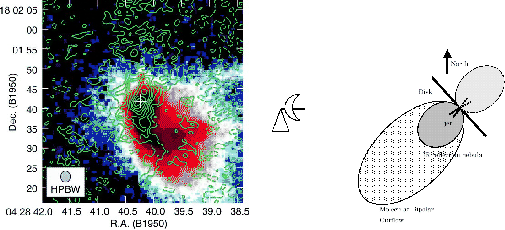



Next: Infall Motion
Up: Protostars
Previous: B335
Contents
Figure 1.14:
(Left:)  CO column density distribution.
The contour lines represent the distribution of
CO column density distribution.
The contour lines represent the distribution of  CO column density.
2.2
CO column density.
2.2  m infra-red reflection nebula is shown in grey scale which was
observed by Hoddap (1994).
(Right:) Schematic view of L1551 IRS5 region.
m infra-red reflection nebula is shown in grey scale which was
observed by Hoddap (1994).
(Right:) Schematic view of L1551 IRS5 region.
 |
L1551 IRS 5 is one of the most well studied protostellar objects.
This has an infra-red emission nebulosity (Fig.1.14).
It is believed that there is a hole perpendicular to the high-density disk and
the emission from the central star escapes through the hole and irradiate the nebulosity.
In this sense this is a reflection nebula.
L1551 IRS 5 has an elongated structure of dense gas similar to that observed in B335.
The gas is extending in the direction from north-west to south-east [Fig.1.14 (left)].
Since the opposite side of the nebulosity is not observed, the opposite side of nebulosity
seems to be located beyond the high-density disk and be obscured by the disk.
This is possible if we see the south surface of the high-density disk as
in Figure 1.14 (right).
Subsections




Next: Infall Motion
Up: Protostars
Previous: B335
Contents
Kohji Tomisaka
2007-07-08

